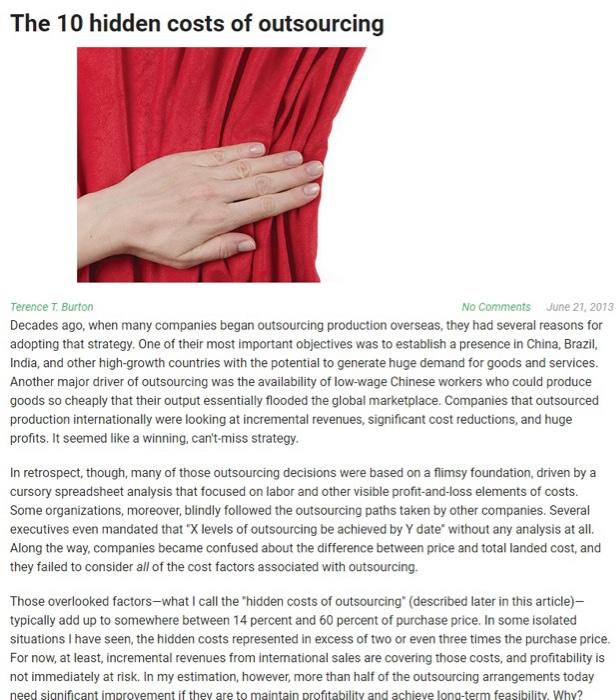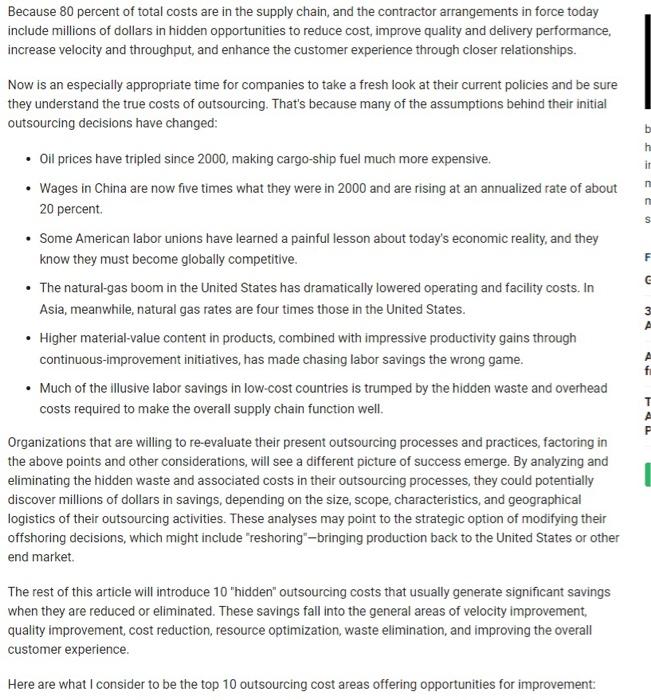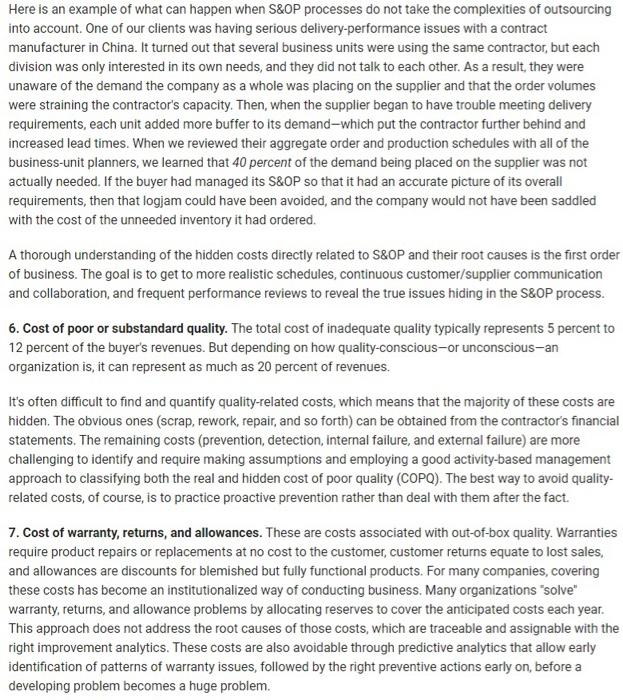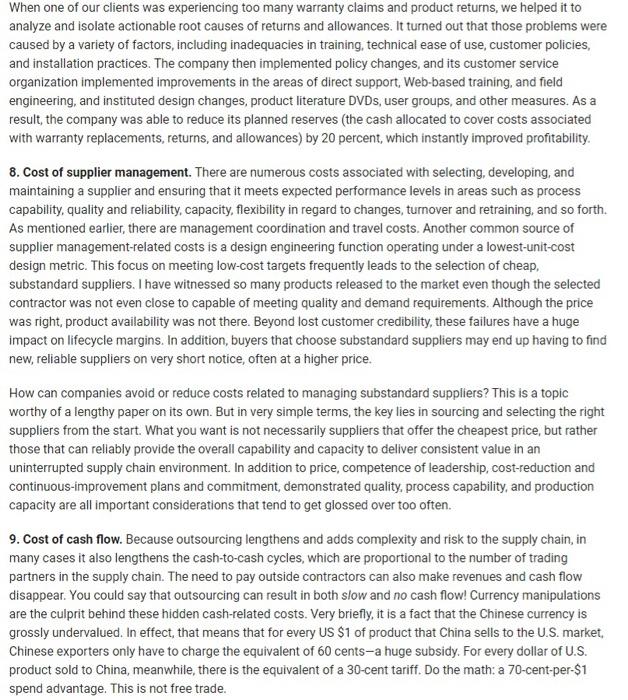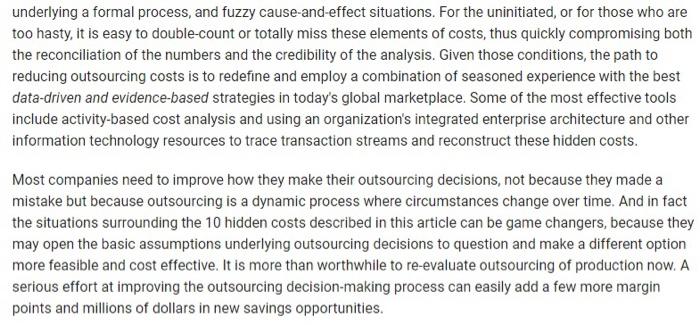1 which two"hidden" cost do you identify with or think are most important?
2 Do some light resarch and give an example of these two with company that you can find information about.
The 10 hidden costs of outsourcing Terence T. Burton No Comments June 21,2013 Decades ago, when many companies began outsourcing production overseas, they had several reasons for adopting that strategy. One of their most important objectives was to establish a presence in China, Brazil, India, and other high-growth countries with the potential to generate huge demand for goods and services. Another major driver of outsourcing was the availability of low-wage Chinese workers who could produce goods so cheaply that their output essentially flooded the global marketplace. Companies that outsourced production internationally were looking at incremental revenues, significant cost reductions, and huge profits. It seemed like a winning, can't-miss strategy. In retrospect, though, many of those outsourcing decisions were based on a flimsy foundation, driven by a cursory spreadsheet analysis that focused on labor and other visible profit-and-loss elements of costs. Some organizations, moreover, blindly followed the outsourcing paths taken by other companies. Several executives even mandated that ' X levels of outsourcing be achieved by Y date" without any analysis at all. Along the way, companies became confused about the difference between price and total landed cost, and they failed to consider all of the cost factors associated with outsourcing. Those overlooked factors-what I call the "hidden costs of outsourcing" (described later in this article)typically add up to somewhere between 14 percent and 60 percent of purchase price. In some isolated situations I have seen, the hidden costs represented in excess of two or even three times the purchase price. For now, at least, incremental revenues from international sales are covering those costs, and profitability is not immediately at risk. In my estimation, however, more than half of the outsourcing arrangements today need significant improvement if they are to maintain profitability and achieve lono-term feasibility. Why? Because 80 percent of total costs are in the supply chain, and the contractor arrangements in force today include millions of dollars in hidden opportunities to reduce cost, improve quality and delivery performance, increase velocity and throughput, and enhance the customer experience through closer relationships. Now is an especially appropriate time for companies to take a fresh look at their current policies and be sure they understand the true costs of outsourcing. That's because many of the assumptions behind their initial outsourcing decisions have changed: - Oil prices have tripled since 2000, making cargo-ship fuel much more expensive. - Wages in China are now five times what they were in 2000 and are rising at an annualized rate of about 20 percent. - Some American labor unions have learned a painful lesson about today's economic reality, and they know they must become globally competitive. - The natural-gas boom in the United States has dramatically lowered operating and facility costs. In Asia, meanwhile, natural gas rates are four times those in the United States. - Higher material-value content in products, combined with impressive productivity gains through continuous-improvement initiatives, has made chasing labor savings the wrong game. - Much of the illusive labor savings in low-cost countries is trumped by the hidden waste and overhead costs required to make the overall supply chain function well. Organizations that are willing to re-evaluate their present outsourcing processes and practices, factoring in the above points and other considerations, will see a different picture of success emerge. By analyzing and eliminating the hidden waste and associated costs in their outsourcing processes, they could potentially discover millions of dollars in savings, depending on the size, scope, characteristics, and geographical logistics of their outsourcing activities. These analyses may point to the strategic option of modifying their offshoring decisions, which might include "reshoring"bringing production back to the United States or other end market. The rest of this article will introduce 10 "hidden" outsourcing costs that usually generate significant savings when they are reduced or eliminated. These savings fall into the general areas of velocity improvement, quality improvement, cost reduction, resource optimization, waste elimination, and improving the overall customer experience. Here are what I consider to be the top 10 outsourcing cost areas offering opportunities for improvement: 1. Cost of an outdated outsourcing strategy. This cost-reduction opportunity involves a rationalization and reassessment of the current outsourcing portfolio in terms of revenue topology (where and how sold) versus the sourcing decisions (where made) that drive costs. Markets shift over time, which may drive up logistics, transportation, in-transit handling damage, and other hidden management costs. An effective tactic in this regard is to review the outsourcing content and commitment levels for individual country sites, and plan how to relocate parts of those operations (for example, a segment of the final assembly) to respond to emerging market opportunities in other countries. For example, if 100 percent of the design and manufacturing for a product is located in China, it would be difficult to serve an emerging or fast-growing market in Brazil or Los Angeles. A solid analysis of the facts may result in adjustments to sourcing decisions (source/build location, content, and fulfillment strategies) and the associated costs. In a few cases, the data may justify returning some manufacturing to the United States or other end market. 2. Cost of management and coordination of contractors. People often are shocked when they calculate the total annualized cost of management and coordination of outsourced production. This includes the cost of employees' time and travel expenses incurred when they visit suppliers, plus any other identifiable lost opportunities, such as lost sales, missed market opportunities, warranty and returns, and loss of customer confidence. The cost of these activities can quickly add up to millions of dollars, much of it symptomatic of deeper problems, such as weak local leadership, poor direction of the outsourcing supplier by the buyer, or bad supplier selection. To keep those costs under control, collect and analyze the relevant data over time; play the "5 Why" game developed under the Toyota Production System (asking why something happened, and then questioning each subsequent answer until you find the root cause of the problem); and segment the recurring root causes into various priority and corrective-action buckets. Then you will have an actionable basis for reducing management and coordination costs. 3. Cost of subpar inventory performance. Outsourcing manufacturing reduces flexibility in design as well as the ability to respond to schedule changes. This usually translates into more inventory in the global pipeline, more mismatches between supply and demand, more shrinkage from variances (count errors, theft, weak disciplines, and so forth), and more excess and obsolete inventory. Additionally, think of what happens in many organizations at the end of the month, when planned inventory is not available for sale due to the reasons above. Rather than selling the higher-margin items as planned, they end up selling whatever they have on hand in the warehouse to make sales quotas. Then there is the "cost of lost sales" element. Depending on the product, back orders can push customers that really need the unavailable product to a competitor that can meet their requirements. These hidden, inventory-related costs alone could add up to 10 percent or more of total revenues. With outsourcing, an "all things to all customers" strategy just doesn't work. Product-line rationalization and pruning, and a more segmented demand-chain strategy that recognizes the unique requirements of different demand streams helps this situation. However, these types of analyses are not easy and require constant attention to changing markets. One needs to evaluate various fulfillment options in light of different demand stream characteristics, but using real data and facts (rather than reactionary perceptions and opinions) greatly helps the process. For example, if you are a large retailer, the fulfillment strategy for large, highvolume furniture items in the suburbs of a large city should be different than the fulfillment strategy for small, low-volume items like vases in a rural area. Demand chain management is a critical enabler of profitable cash-to-cash cycles. 4. Cost of unplanned logistics activities and premium freight. Outsourcing reduces flexibility and therefore makes it difficult to be responsive to changing customer requirements. Furthermore, outsourcing increases the distance and the number of touch points between order entry and order fulfillment. Poor planning and oversight in such a highly complex demand and supply chain leads to unnecessary expenses. For example, when many "hands" are involved, the right products in the right mix and volumes may not be in the right places at the right time. For example, a product needed for a U.S. customer may sit in a European distribution center, or product needed by a distributor in one city may be delivered to another distributor that does not need it. When those types of mistakes happen, companies end up spending a lot of money to move product at the last minute by air. Companies can prevent such mistakes and the resulting "emergencies" through better planning and control over deliveries of outsourced products. In one organization, for example, the chief executive officer (CEO) walked through the purchasing department and said, "Whatever you do, don't run out of material. Use premium freight if you need to." You can guess the rest of the story: More than half of the items delivered at the receiving dock arrived via premium freight, even though they were no longer required or they weren't needed yet. When the company fixed this situation through instituting better controls, including requiring approval for and exercising more discretion over the use of premium freight, it netted a $680,000 savings. 5. Cost of inappropriate sales and operations planning (S\&OP). There are significant costs associated with sales and operations planning in an outsourced environment, where additional complexity increases both risks and costs. For example, because outsourcing has lengthened the fulfillment pipeline, schedule changes tend to have a much larger impact than in the past, when a manager could walk out to the plant or drive down the street to visit a supplier in order to find out what was going on and make adjustments if needed. In addition, having to manage multiple demand streams among a network of contractors has added complexity. Yet many companies fail to recognize the need to modify the S\&OP process when outsourcing is involved. Here is an example of what can happen when S\&OP processes do not take the complexities of outsourcing into account. One of our clients was having serious delivery-performance issues with a contract manufacturer in China. It turned out that several business units were using the same contractor, but each division was only interested in its own needs, and they did not talk to each other. As a result, they were unaware of the demand the company as a whole was placing on the supplier and that the order volumes were straining the contractor's capacity. Then, when the supplier began to have trouble meeting delivery requirements, each unit added more buffer to its demand-which put the contractor further behind and increased lead times. When we reviewed their aggregate order and production schedules with all of the business-unit planners, we learned that 40 percent of the demand being placed on the supplier was not actually needed. If the buyer had managed its S\&OP so that it had an accurate picture of its overall requirements, then that logjam could have been avoided, and the company would not have been saddled with the cost of the unneeded inventory it had ordered. A thorough understanding of the hidden costs directly related to S\&OP and their root causes is the first order of business. The goal is to get to more realistic schedules, continuous customer/supplier communication and collaboration, and frequent performance reviews to reveal the true issues hiding in the S\&OP process. 6. Cost of poor or substandard quality. The total cost of inadequate quality typically represents 5 percent to 12 percent of the buyer's revenues. But depending on how quality-conscious-or unconscious-an organization is, it can represent as much as 20 percent of revenues. It's often difficult to find and quantify quality-related costs, which means that the majority of these costs are hidden. The obvious ones (scrap, rework, repair, and so forth) can be obtained from the contractor's financial statements. The remaining costs (prevention, detection, internal failure, and external failure) are more challenging to identify and require making assumptions and employing a good activity-based management approach to classifying both the real and hidden cost of poor quality (COPQ). The best way to avoid qualityrelated costs, of course, is to practice proactive prevention rather than deal with them after the fact. 7. Cost of warranty, returns, and allowances. These are costs associated with out-of-box quality. Warranties require product repairs or replacements at no cost to the customer, customer returns equate to lost sales, and allowances are discounts for blemished but fully functional products. For many companies, covering these costs has become an institutionalized way of conducting business. Many organizations "solve" warranty, returns, and allowance problems by allocating reserves to cover the anticipated costs each year. This approach does not address the root causes of those costs, which are traceable and assignable with the right improvement analytics. These costs are also avoidable through predictive analytics that allow early identification of patterns of warranty issues, followed by the right preventive actions early on, before a developing problem becomes a huge problem. When one of our clients was experiencing too many warranty claims and product returns, we helped it to analyze and isolate actionable root causes of returns and allowances. It turned out that those problems were caused by a variety of factors, including inadequacies in training, technical ease of use, customer policies, and installation practices. The company then implemented policy changes, and its customer service organization implemented improvements in the areas of direct support, Web-based training, and field engineering, and instituted design changes, product literature DVDs, user groups, and other measures. As a result, the company was able to reduce its planned reserves (the cash allocated to cover costs associated with warranty replacements, returns, and allowances) by 20 percent, which instantly improved profitability. 8. Cost of supplier management. There are numerous costs associated with selecting, developing, and maintaining a supplier and ensuring that it meets expected performance levels in areas such as process capability, quality and reliability, capacity, flexibility in regard to changes, turnover and retraining, and so forth. As mentioned earlier, there are management coordination and travel costs. Another common source of supplier management-related costs is a design engineering function operating under a lowest-unit-cost design metric. This focus on meeting low-cost targets frequently leads to the selection of cheap, substandard suppliers. I have witnessed so many products released to the market even though the selected contractor was not even close to capable of meeting quality and demand requirements. Although the price was right, product availability was not there. Beyond lost customer credibility, these failures have a huge impact on lifecycle margins. In addition, buyers that choose substandard suppliers may end up having to find new, reliable suppliers on very short notice, often at a higher price. How can companies avoid or reduce costs related to managing substandard suppliers? This is a topic worthy of a lengthy paper on its own. But in very simple terms, the key lies in sourcing and selecting the right suppliers from the start. What you want is not necessarily suppliers that offer the cheapest price, but rather those that can reliably provide the overall capability and capacity to deliver consistent value in an uninterrupted supply chain environment. In addition to price, competence of leadership, cost-reduction and continuous-improvement plans and commitment, demonstrated quality, process capability, and production capacity are all important considerations that tend to get glossed over too often. 9. Cost of cash flow. Because outsourcing lengthens and adds complexity and risk to the supply chain, in many cases it also lengthens the cash-to-cash cycles, which are proportional to the number of trading partners in the supply chain. The need to pay outside contractors can also make revenues and cash flow disappear. You could say that outsourcing can result in both slow and no cash flow! Currency manipulations are the culprit behind these hidden cash-related costs. Very briefly, it is a fact that the Chinese currency is grossly undervalued. In effect, that means that for every US $1 of product that China sells to the U.S. market, Chinese exporters only have to charge the equivalent of 60 cents-a huge subsidy. For every dollar of U.S. product sold to China, meanwhile, there is the equivalent of a 30 -cent tariff. Do the math: a 70 -cent-per-\$1 spend advantage. This is not free trade. Shifting production closer to the end market instead of offshoring to a contract manufacturer often can speed up cash flow. One organization I know of was on a 90AA~iic1/2il1/2120-day cycle and had profit-and-loss, inventory, quality, and cash-flow issues. An analysis revealed that over 90 percent of a high-margin product line manufactured in China was being sold in the U.S. market, specifically to customers in the Midwest and on the West Coast. Additional analysis revealed similar results for a few other product lines. The company found that if it moved production of several product lines back to the United States, those products could be manufactured at a lower total cost and be shipped directly to customers with a net 30 days invoice. That's exactly what the manufacturer did, and all problems were solved: product availability, quality and reliability, order fulfillment, customer satisfaction, incremental revenues, and cash flow all improved. No currency issues, either. 10. Cost of unplanned and unforeseen risks. Organizations that outsource production tend to overvalue the labor savings they expect to gain from outsourcing and undervalue all the other potential costs and risks. These include such underhanded practices as intellectual property theft, and product and component piracy and theft that may be acceptable or are rarely (if ever) prosecuted in some countries where outsourcing is common. In fact, the risk of unauthorized copying of products increases when outsourced manufacturing is involved. One of our clients, for instance, discovered that a supplier was selling the client's parts and components to a family member, who then reproduced the branded product and was selling it for US $600 less than the originals. This kind of product piracy can generate additional hidden costs, such as warranties and repairs that the legitimate company may end up paying for. In addition to "man-made" risk, unpredictable situations like tsunamis, earthquakes, and other natural disasters add irreversible costs to the outsourcing process. It's imperative, therefore, that responses or contingency plans for dealing with all of the possible risks and potential consequences be integrated into any outsourcing strategy. This will allow you to mitigate the costs of those consequences and recover more quickly. UNCOVER HIDDEN COSTS It is no secret that most decisions to outsource production were fueled by the expectation of huge labor savings. But the largest cost driver in many products today is materials, not labor-so chasing labor savings is yesterday's game. Still, some executives are reluctant to revisit their past decisions. This is unwise, because complacency, postponement, or procrastination about improving outsourcing costs are not winning strategies for future success. In fact, there is a lot of "gold" to be found in the outsourcing practices of most organizations, but it's not easy to uncover these hidden costs. Because outsourced production involves a complex network of transactional processes, it obscures a significant array of costs. Complicating matters is the fact that outsourcing involves a lot of unpredictability, professional judgments versus hard data, a high degree of informal activities underlying a formal process, and fuzzy cause-and-effect situations. For the uninitiated, or for those who are too hasty, it is easy to double-count or totally miss these elements of costs, thus quickly compromising both the reconciliation of the numbers and the credibility of the analysis. Given those conditions, the path to reducing outsourcing costs is to redefine and employ a combination of seasoned experience with the best data-driven and evidence-based strategies in today's global marketplace. Some of the most effective tools include activity-based cost analysis and using an organization's integrated enterprise architecture and other information technology resources to trace transaction streams and reconstruct these hidden costs. Most companies need to improve how they make their outsourcing decisions, not because they made a mistake but because outsourcing is a dynamic process where circumstances change over time. And in fact the situations surrounding the 10 hidden costs described in this article can be game changers, because they may open the basic assumptions underlying outsourcing decisions to question and make a different option more feasible and cost effective. It is more than worthwhile to re-evaluate outsourcing of production now. A serious effort at improving the outsourcing decision-making process can easily add a few more margin points and millions of dollars in new savings opportunities
